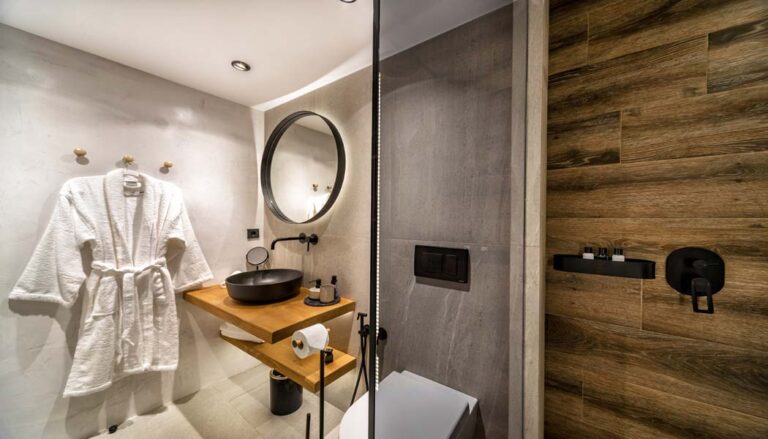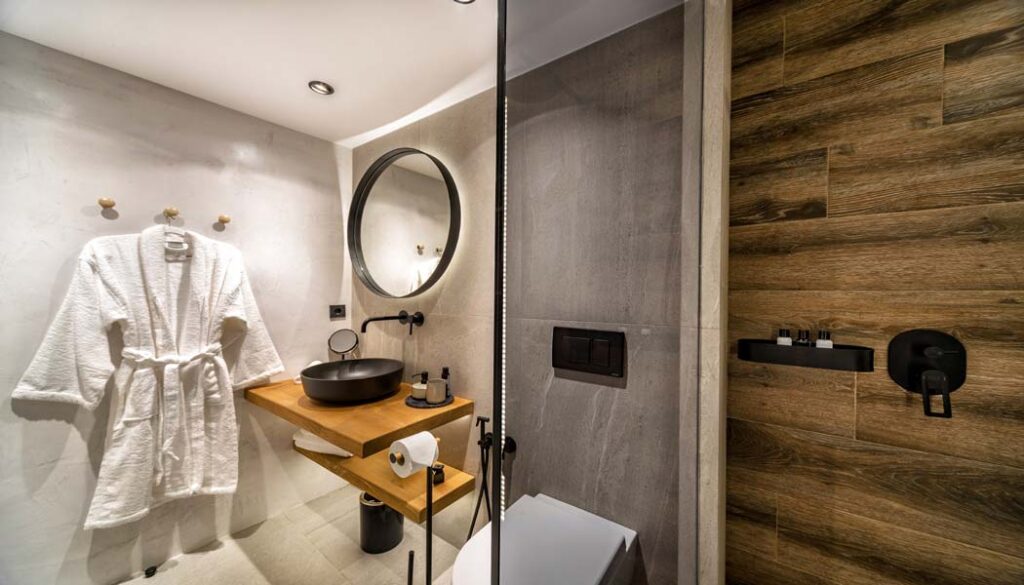
How to Paint Laminate Walls in Bathroom?
If you’re looking to give your bathroom a fresh new look, painting your laminate walls can be a cost-effective and fun way to do it. Laminate walls are a popular choice in bathrooms because of their durability and water resistance, but they can sometimes feel a bit dated.
Need to paint your laminate walls? But thinking about how to paint laminate walls in bathroom? Just clean the surface, sand the laminate to create texture, and use a primer specifically designed for laminate surfaces. Then apply two coats of paint.

As someone who has tackled this project before, let me share some details tips, and insights to help you get the job done right and create the bathroom of your dreams.
Can You Paint Over Laminate Bathroom Walls?
Yes, it is possible to paint over laminate bathroom walls. Laminate walls can be difficult to paint due to their smooth, non-porous surface. However, with proper preparation and high-quality paint and primer, you can achieve a durable and long-lasting finish.
It’s important to clean the walls thoroughly to remove any dirt, grime, or soap residue, and lightly sand the surface to create texture for better paint adhesion. Using a primer specifically designed for laminate surfaces will help the paint adhere and prevent peeling or chipping over time.
Why You Would Paint Laminate Walls?
There are several reasons why you might choose to paint laminate walls. Here are some of the main reasons:
To update the look of the room:
Laminate walls can look outdated or tired over time. Painting them is a cost-effective way to give the room a fresh, new look.
To personalize the space:
If you’ve recently moved into a new home or apartment and the laminate walls don’t fit your personal style, painting them is an easy way to make the space feel more like your own.
To protect the walls:
If the laminate walls are in an area of the home that is prone to moisture, such as a bathroom or laundry room, painting them can help protect them from water damage.
To cover up imperfections:
Laminate walls can be difficult to repair if they become scratched or chipped. Painting over them can help hide any imperfections and give them a smooth, even finish.
By painting your laminate walls, you can transform the look and feel of your space while also protecting them from potential damage.
How to Paint Laminate Walls in Bathroom?
Fortunately, with a little bit of preparation and the right tools, painting your laminate walls can be a straightforward process that transforms your bathroom into a stylish and modern space.
List of materials you’ll need to paint:
- Degreaser or cleaning solution
- Sandpaper (fine-grit)
- Damp cloth
- Drop cloths or plastic sheeting to protect floors and fixtures
- Painter’s tape (if needed)
- Primer specifically designed for laminate surfaces
- Paint (specifically formulated for use in a bathroom)
- Paint roller or brush
- Paint tray (if needed)
- Stir sticks (to stir the paint and primer)
- Paint can opener (if needed)
- Gloves (to protect your hands)
- Respirator or face mask (if desired for added protection)
Having all of these materials on hand before beginning the project will ensure that you have everything you need to complete the job efficiently and effectively.
Clear the room:
Remove any fixtures, accessories, or decorations from the walls and cover the floors and any remaining fixtures with drop cloths to protect them from paint splatters.
Clean the walls:
Use a degreaser or cleaning solution to thoroughly clean the walls and remove any dirt, grime, or soap residue. Rinse the walls with water and allow them to dry completely.
Sand the walls:
Using a fine-grit sandpaper, lightly sand the walls to create a slightly rough texture that will help the primer and paint adhere better. Wipe down the walls with a damp cloth to remove any dust.
Apply a primer:
Apply a primer specifically designed for laminate surfaces. Use a brush or roller to apply the primer in a thin, even layer. Allow the primer to dry completely before proceeding to the next step.
Paint the walls:
Apply two coats of paint to get an excellent finish. Use a roller or brush to do this task. After applying the first coat, take time to dry thoroughly. Once you notice the first coat is dried, then apply the next. It’s important to use paint that is specifically formulated for use in a bathroom to ensure it can withstand moisture and frequent cleaning.
Reinstall fixtures and accessories:
Once the paint has dried completely, reinstall any fixtures or accessories that were removed from the walls.
What Kind of Paint Should You Use on Bathroom Laminate Walls?
When painting bathroom laminate walls, it’s important to use a paint that is specifically formulated for use in a high-moisture environment. Here are the key points to consider when choosing paint for bathroom laminate walls:
Choose bathroom or kitchen and bath paint:
Use a paint specifically labeled for “bathroom paint” or “kitchen and bath paint”. These paints are designed to withstand moisture and frequent cleaning, which is important in a bathroom where the walls are exposed to water and humidity.
Use non-porous paint:
It’s also important to choose a paint that is appropriate for use on laminate surfaces. Laminate walls have a smooth, non-porous surface that requires a paint formulated for this type of surface.
Look for mildew-resistant or mold-resistant paint:
Use a paint that is mildew-resistant or mold-resistant to prevent the growth of mold and mildew in your bathroom.
Select a satin or semi-gloss finish:
A satin or semi-gloss finish is easier to clean and is more resistant to water and humidity than flat or matte finishes.
Consider the color of the paint:
Lighter colors can make the bathroom feel brighter and more spacious, while darker colors can add drama and sophistication to your bathroom.
By following these key points, you can choose a paint that will provide a durable, long-lasting finish on your bathroom laminate walls.
If you’re unsure about which paint to choose, speak to a professional at a paint or home improvement store. They can recommend a paint that is appropriate for your specific bathroom and laminate walls.
Can You Paint Directly onto Laminate?
While it is technically possible to paint directly onto the laminate without using a primer, it is not recommended.
Therefore, it is suggested to use a primer specifically formulated for use on non-porous surfaces like laminate before painting.
Skipping the primer can lead to a subpar paint job that may be prone to chipping, peeling, or cracking over time.
Do You Need Primer To Paint Laminate?
Yes, it is highly recommended to use a primer when painting laminate surfaces, including laminate walls. Laminate is a smooth, non-porous material that can be difficult for paint to adhere to without proper preparation.
A primer will help the paint adhere more effectively to the surface, creating a more durable and long-lasting finish.
Additionally, a primer can help to block any stains or discolorations that may be present on the surface of the laminate, which can affect the appearance of the final paint job. Using a high-quality primer specifically formulated for use on non-porous surfaces like laminate will help ensure the success of your painting project.
Final Words
Painting laminate walls in a bathroom can be a great way to update the look of your space without a major renovation. However, it is important to use the right materials and follow the proper steps to ensure a long-lasting and professional-looking finish.
Selecting the right type of paint, primer, and tools, as well as properly preparing the surface, are key to achieving a successful paint job on laminate walls.
By following the steps outlined in this guide, you can transform your bathroom laminate walls and enjoy a beautiful, updated space.
Remember, taking the time to properly prepare and prime the surface before painting will help ensure a smooth and durable finish that will hold up to the demands of a bathroom environment.
